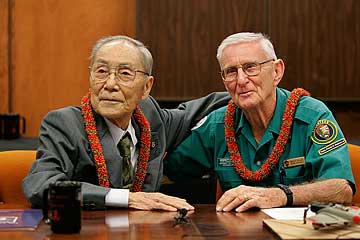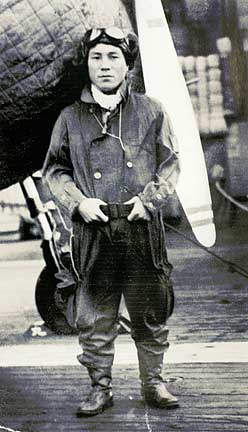
STAR-BULLETIN / 2001
Pearl Harbor veteran Dick Fiske, left, hugs Japanese bomber pilot Zenji Abe during ceremonies at the Hilton Hawaiian Village. The pair became friends after meeting on the "Today" show in 1991 and became a symbol for the war's reconciliation. CLICK FOR LARGE
|
|
Japanese pilot became reconciliation icon
Zenji Abe / World War II Veteran
Zenji Abe, the Japanese pilot who participated in the Dec. 7, 1941, attack on Pearl Harbor and later became a symbol of reconciliation and peace between U.S. and Japanese veterans, died in Ibaraki prefecture in Japan last Friday. He was 92.
Daniel Martinez, U.S. National Park historian at the USS Arizona Memorial, said he was informed of Abe's death by Abe's daughter, Naomi Shin.
Abe was a dive bomber from the Japanese aircraft carrier Akagi that made the attack on the Pacific Fleet anchored at Pearl Harbor nearly 66 years ago as part of the second wave that arrived over Oahu at 9 a.m.
He authored a book on his memoirs of the attack, "The Emperor's Sea Eagle," which was first printed in Japanese and later reprinted in English by the National Park Service, Martinez said.
Martinez said he first met Abe in the early 1980s when Abe came to the Arizona Memorial with a group of about 10 Japanese pilots.
"They came unannounced," Martinez recalled, "because they didn't know how they would be received."
Martinez said that "Abe was so taken back by the nice and cordial" reception they received from Park Service officials that "he thought that it was time to do what he wanted to do for a long time. That was to meet with American veterans and extend his hand in peace and reconciliation."

COURTESY PHOTO
Zenji Abe stands on the flight deck of the aircraft carrier Akagi one week before the attack on Pearl Harbor. CLICK FOR LARGE
|
|
It finally happened in May 1991 -- five months prior to the 50th anniversary of the Japanese attack on Pearl Harbor -- when Abe met with three survivors from Atlanta and shook their hands on the "Today" morning television show.
At that time, Dick Fiske was serving as a volunteer at the memorial, Martinez said, "and watched from afar and met Abe for the first time."
On Dec. 7, 1941, Fiske was a 19-year-old Marine bugler who was serving on the battleship USS Virginia.
During the 50th-anniversary remembrance, a bond developed between Abe and Fiske. Abe asked Fiske to lay two roses at the memorial each month to honor both the Japanese and American victims of the attack.
"Dick would first play taps for the American victims," Martinez said, "and then he would play the Japanese taps for the Japanese sailors and soldiers who lost their lives. Dick did that until he passed away."
"They became the symbol for the reconciliation that had been so difficult between American and Japanese veterans because of the bitterness of the war. That is a part of Abe's legacy."
"Abe was the first," Martinez said. "He also understood that not all veterans could shake hands. But the ones that he could touch, he wanted to do that."

